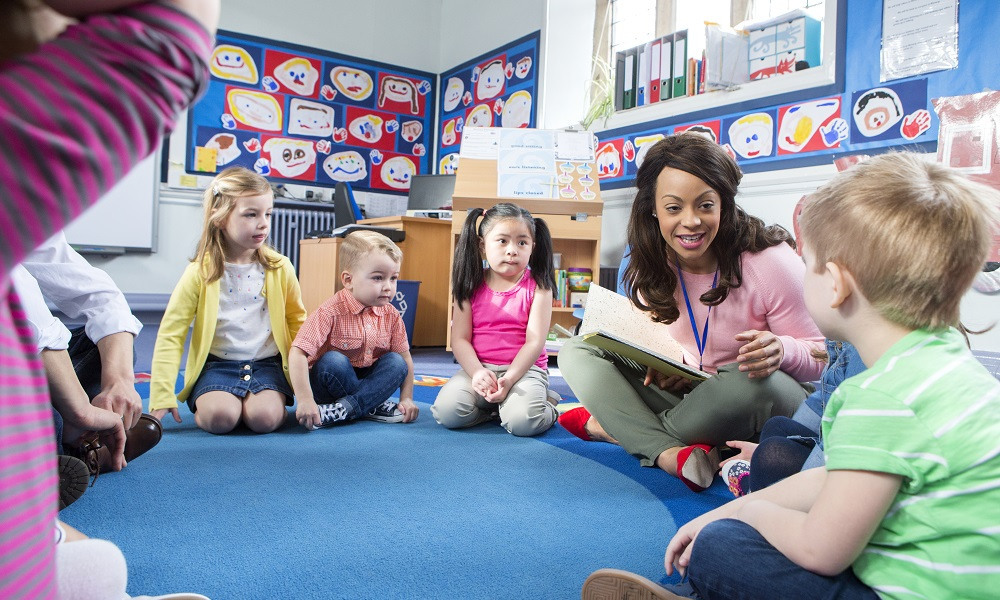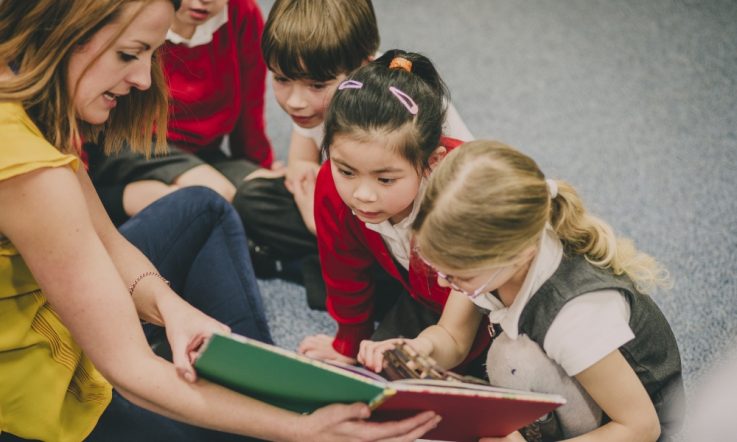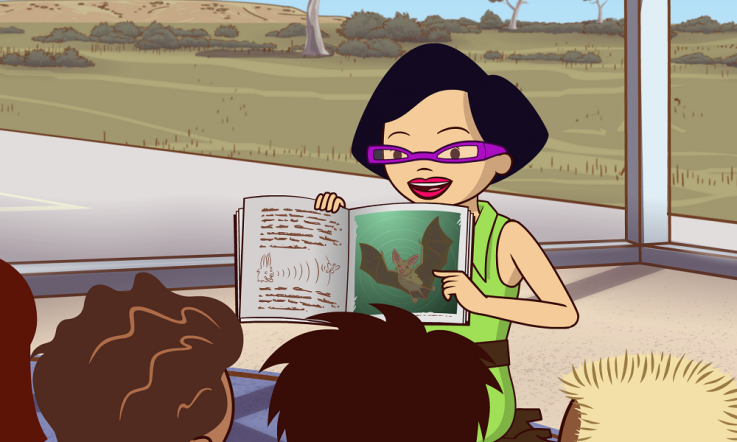This podcast from Teacher is supported by Seven Steps to Writing Success. Transform your writing classroom today! Engage your students and improve results. Visit sevenstepswriting.com
Hello, and thank you for downloading this episode of The Research Files from Teacher magazine. I'm Rebecca Vukovic.
If you were to visit any preschool or kindergarten classroom, you'd surely find that shared book reading is a common activity used to facilitate discussions and support a young child's language and literacy development. A new study, published in Early Childhood Research Quarterly, examined the extent to which preschool teachers use different types of questions during classroom-based shared book reading. Researchers from the Children's Learning Institute at the University of Texas, Ohio State University, the American Institute for Research and Michigan State University all collaborated on this study.
They found that only 24 per cent of what teachers said during the shared book reading were questions, and the kids answered the questions accurately 85 per cent of the time. In today's episode, I'm joined by one of the study's authors, Dr Tricia Zucker, who is an Associate Professor with the Children's Learning Institute at McGovern Medical School at UTHealth in Houston. We chat about what the main findings were to come from the research, whether the questions teachers were asking were too simple for students, and how teachers could improve their questioning practices to ensure children are given the appropriate level of challenge. To get it all started, here is Dr Zucker explaining what the aims were for the study.
Tricia Zucker: Well we were quite interested in studying the types of questions that preschool and kindergarten teachers ask children when they read books to children. And it's a very common practice in early childhood classrooms and I'm sure most of us grew up having stories read to us. But, we wanted to really describe in great detail the types of questions teachers ask and what happens when children are given a chance to answer those questions.
Rebecca Vukovic: Fantastic. So let's cover all the basics to begin. Who was involved in the study? Where were they located? And when did it all take place?
TZ: Yes well we have been doing this work for about the last four to five years and the study took place in the south central and mid-western United States. So we had two different sites and we worked with 82 pre-kindergarten teachers, so they're teaching four-year-olds and 14 kindergarten teachers. So most of the kids were ages three to five-and-a-half with a mean age of four years old.
RV: Okay fantastic. So let's delve into it now then. How did you actually go about conducting the study?
TZ: Well this is a study that was part of a larger project funded by the Department of Education's Institute of Education Sciences with the aim of developing better measures of classroom discourse qualities. So we want to know what are the things teachers and kids talk about and how can we best measure that? So we set out to measure this in the context of book reading because as I said, it's a familiar, every day activity. And also it's a controlled sort of stimulus event, where there's a definite starting point and a definite ending point of when you start reading the book and you finish discussing it. So the larger project was called the Systematic Assessment of Book Reading and we developed a measure of book reading that is available at no cost through our university websites. So that's a long way to say that when we went about conducting the study we were really focused on using the right books, the right materials for teachers to read to kids.
RV: Yeah and I'm curious about how you actually went about choosing the book because as you said, all the teachers in the study read the same text, which was Kingdom of Friends, a book you co-authored with Jill Pentimonti. Was there a specific reason for choosing this book?
TZ: Yes, we had several reasons that we actually developed this book ourselves. The first was that as part of the research and the assessment, we did not want there to be differences across classrooms such that some teachers had read the book to their students before and others were unfamiliar with it. So in some of our past studies, we have used books like The Very Hungry Caterpillar, and of course this is a widely known book but maybe some newer teachers haven't read this book to their students whereas other teachers are quite familiar with it and would even bring out props and things like that. So we wanted to not have any differences related to familiarity of the text, so that was one reason we went about authoring the book ourselves.
And then the second reason is that as part of the larger body of research on the qualities of book reading, we wanted to create a narrative text and an informational text that were equivalent in length and equivalent in the number of sophisticated vocabulary words. So the particular study we're talking about today focuses on the narrative text called Kingdom of Friends but we have a larger set of work looking at how this type of reading compares to informational text reading. And finally, the last reason we chose this book or we wrote the book the way we did is that we wanted this to be a very emotional narrative that dealt with a topic of high salience to young children. Pre-school and kindergarten teachers report that to be ready for school, one of the most important things that young children need is to be able to control their strong emotions.
So we wrote a book about some very strong emotions, the main character is named Petunia and she gets a bit bossy with her best friend, Diego, and they run into a huge problem during their play time and she kicks down this tower they have worked on together; she really becomes enraged and he becomes quite frustrated too. So this is all to say that what we did is we made sure that we had a book that covered the full range of positive and negative emotions so that that we would hopefully elicit lots of conversation about the things that matter for young children in terms of being able to regulate their emotions and even just name their emotions.
Coming up: Dr Zucker discusses the main findings to come from this research, and talks us through some of the learning opportunities that are missed by teachers asking questions that are just too simple for students. But first, here's a quick message from our sponsor.
This podcast from Teacher is supported by Seven Steps to Writing Success. Imagine a vibrant writing classroom where every student is engaged, contributing ideas and sharing their work with excitement. That's what a Seven Steps classroom looks like. Visit sevenstepswriting.com to start transforming writing in your school today.
RV: So let's talk about the findings from the study now. So, when reading the book to students, what were the different types of questions that teachers asked and what type of response did they elicit?
TZ: Well we looked at seven different categories of questions and what we found, descriptively, is first that questions were about 24 per cent of what teachers did as they spoke to kids. And that's quite normal. We see in the larger literature that about 25-35 per cent of what teachers say is questions. So, then amongst that set of questions we dug deeper into okay, let's look at exactly what types of questions we saw. And the most frequent type of questions asked are what we call ‘Wh' questions. So these are ‘Who, What, When' type of questions. And this also was quite similar to what we were expecting as well as there were a large number of yes/no questions so those are questions that just require a simple ‘yes' or ‘no' response.
‘Wh' questions, those happen about one-and-a-half times per minute, so that was about 41 per cent of all questions. And then the next most common type of question was auxiliary fronted questions and those happened about every minute so that's 27 per cent of questions. And then what we saw the least of were questions that we call Why questions or How/procedural questions so these questions only happened about 3 or 4 per cent of all the questions and so you would see those happening very rarely, just a few times during book reading that you might hear these nice Why and How questions. And when we looked at what types of responses each question form elicited, that's where the results get really interesting.
So we found that the Why and How questions, they tended to elicit the longest child responses, as well as we looked at whether children's responses were accurate or inaccurate and we found that children gave more inaccurate responses to the Why and How/procedural questions but it wasn't too hard for them. They would have a little bit of difficulty in answering these questions but not too much. In contrast the yes and no type of questions that we saw so many of, kids almost always got those right. Those were very simple and of course, you have a 50 per cent chance of answering that question correctly.
RV: So, do children respond more accurately then to certain types of questions than others?
TZ: So overall, what we saw was that children seemed to find teacher's questions quite easy to answer. In fact, 85 per cent of children's responses to teacher questions were accurate. And when we look more closely, we can see, as I've mentioned that ‘Wh' questions tended to produce a little bit more of those inaccurate responses than some of the other question forms like yes/no questions. But that's actually a good thing. It's really a good thing to see kids struggling a little bit to answer a question because that tells us that we are in the zone where learning happens.
Teachers think of this as the zone of proximal development where a task is not too easy, not too hard but just right. Because it might be a little bit challenging at the first bit of a conversation, that very first question, but what we saw is that our effective teachers go on to have a multiple turn conversation where even though the first response was inaccurate, those teachers stayed with the child and they pulled out an accurate response through some nice scaffolding techniques or by just rephrasing the question in another way to help children come along with this more complex type of reasoning.
RV: And you also examined the relationship between the types of questions asked by the teachers and the length of children's responses, to examine if certain types of teacher questions are more likely to elicit multi-word responses from children. What did you find there?
TZ: Well yeah, these preschool and kindergarten aged children, they're not toddlers, we know that they can give very lengthy responses if given the right opportunity and unfortunately what we found is that most of what children produced were very short responses, single word responses. However, the really fantastic questions are the ones that elicited a longer, multiple word response. And those tended to be questions that were those ‘Wh' questions again, the Who, What, When, Where and also Why questions, produced more multi-word responses.
We were a little surprised to see that a certain type of How question, what we call How/feeling questions like how is the character feeling on this page? Those also tended to elicit just a one word response. So how is he feeling? Well he's mad, or she's sad. And again, our really effective teachers would stick with children and say, ‘Okay, you've now given me a correct response, but let's talk more. Well okay he is feeling sad. Why is he feeling so sad? Oh you think it's because she's being a little bit too bossy and not giving him a chance to make any choices for what they're going to play.' So those are some of our next steps actually, is to keep looking at how teachers carry forward, not just that first question, but how do they develop a whole conversation that really supports kids learning and language development.
RV: So overall, your results from this study show that the questions teachers ask do not seem to challenge children enough, given they were able to answer the vast majority of them accurately. So, I was wondering then, what kind of learning opportunities are being missed?
TZ: Well, you're right. One of our takeaways and what we concluded from the study is that there is a missed opportunity here to really challenge kids and to move into the zone of proximal development. Or to find those teachable moments where a question is a little challenging for kids. As a teacher, we should really welcome these inaccurate responses because that's where we can come in and help them to have an opportunity for learning by reframing the initial question or helping them to think about it in another way through a scaffold.
So when we saw that 85 per cent of questions were answered accurately, that is a disconnect from the larger literature where theory suggests that you want about maybe 30-40 per cent of questions that you ask to be challenging. You do want about 30 per cent of responses to be inaccurate because that lets you know that kids are being given an opportunity to learn. So we can't say definitively what the exact proportion of easy to hard questions would look like but these data do suggest that early childhood teachers questions are a little too easy for kids and that it would be a good opportunity to up the ante and expect more from kids, because they can answer these more complicated, inferential level questions.
RV: So how could a teacher improve their questioning practices to ensure that those children are given the opportunity to give the more lengthy responses, and ensure they are provided that level of challenge you spoke about?
TZ: Well that is a great question and I'm going to give you a couple different ideas of ways that teachers can do this. So one thing that our research is suggesting is that a really easy way to move conversation to these higher level ‘Why' and ‘How' questions is to read an informational text. We do tend to see that those types of books just generate more complex language and conversations without much thought, without much extra planning. I would challenge teachers first of all to give kids a good diet of genres of texts so that they're not hearing only narratives but also informational or expository texts, even at these young ages.
The second thing that teachers can do is they can be really intentional and ‘planful' in preparing a set of questions before they read. Now what we tend to do is we provide a lot of training and professional development for teachers where we don't want to overwhelm kids with all these super hard questions on the very first time that they've heard a book, but we want to ask a few simple questions to make sure, check for understanding. Are they tracking? Are they with us? Are they understanding the basics of this story and one you can see that children are understanding? Then it is the time to push conversation to a higher level. So certainly after reading you'd want to ask them questions like what do you think the author wants us to learn from this book? Or, why do you think the characters made the choices they did? And what would you do differently if you were in this situation?
So those are the types of questions that really take some intentional planning because most of the time, by the time you've gotten to the end of a story, the kids are getting a little restless and so you need to make sure that you've got some really meaty questions, already planned, that guide that conversation and perhaps even you have previewed that question before reading and that way the kids know, alright, there's a big question, there's a guiding question where we're going to think about the whole time we're hearing this story and after reading, my teacher is expecting me to have a dialogue about these things. And just setting that expectation for kids, priming kids that they will be expected to answer that sort of question, even little kids can do this and they have greater success when their teachers set them up for these types of really complex conversations, that even four-year-olds are able to produce.
RV: Fantastic, there's lots of practical advice there. Dr Tricia Zucker, thanks for sharing your work with Teacher magazine.
TZ: And I do also want to add a huge thank you to Richa Deshmukh, she is a postdoctoral fellow here at our Institute who led this study and learned how to do all sorts of complex new analyses to complete it. So thank you to Richa and to the larger team at our many institutions – American Institute for Research, Ohio State and here at the University of Texas, that all worked together on this study.
That's all for this episode. I'll include links to the research we've discussed today in the transcript for the podcast, which you'll find, of course on teachermagazine.com.au And if you'd like to listen to more from Teacher, you'll find us by searching ‘Teacher ACER' wherever you get your podcasts – on Apple Podcasts, SoundCloud, and now, on Spotify as well.
You've been listening to a podcast from Teacher, supported by Seven Steps to Writing Success. Transform your writing classroom today! Engage your students and improve results. Visit sevenstepswriting.com
As an early years’ educator, think about how you go about shared book reading in your classroom. Are you asking questions that provide the appropriate level of challenge to students?
How do you go about choosing texts to read in your classroom? What considerations do you keep in mind?



